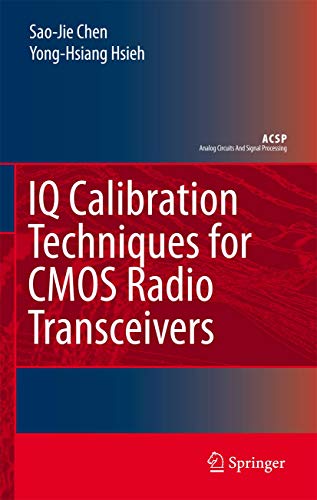IQ Calibration Techniques for CMOS Radio Transceivers (Analog Circuits and Signal Processing) - Softcover

Inhaltsangabe
List of Figures. List of Tables. List of Abbreviations. Preface. Acknowledgments. 1. INTRODUCTION. 1. Wireless LAN Standards. 1.1 IEEE 802.11. 1.2 HiperLan. 1.3 HiperLan II. 1.4 OpenAir. 1.5 HomeRF and SWAP. 1.6 BlueTooth. 2. Wireless in the 21st Century. 3. The 802 Standard and The IEEE. 3.1 IEEE 802.11b. 3.2 IEEE 802.11a. 3.3 IEEE 802.11g. 3.4 Performance and Characeristic. 4. Background and Motivation. 5. IEEE 802.11g RF Transceiver Performance Requirement. 5.1 Synthesizer Output Phase Noise. 5.2 Circuit Linearity. 5.3 Modulator/Demodulator I/Q Gain and Phase Imbalance. 6 Transceiver Design Goal. 6.1 Solutions on I/Q Balance. 2. TRANSCEIVER ARCHITECTURE DESIGN. 1. Receiver Architecture. 1.1 Superheterodyne Receiver. 1.2 Low-IF Receiver. 1.3 Zero-IF Receiver. 2. Comparison of Our Choice. 3. Transceiver Architecture. 4. The Choice of Intermediary Frequency. 5. Receiver Chain Link Budget. 5.1 Receiver Adjacent Channel Rejection. 5.2 Receiver Cascade Gain. 5.3 Receiver Cascade Noise Figure. 5.4 Receiver Dynamic Range. 5.4.1 RF/IF Section Gain Windows. 5.4.2 Receiver IF VGA and I/Q Demodulator Specification. 5.4.3 Cascade Gain of IF/BB. 5.4.4 Cascade Noise Figure of IF/BB. 6. Transmitter Chain Link Budget. 6.1 Transmit Circuits Gain Distribution and Gain Range. 6.2 Transmit Error Vector Magnitude. 6.3 Transmit Signal Spectral Mask. 3. I/Q MODULATOR AND DEMODULATOR DESIGN. 1. I/Q Modulator and Demodulator Architecture Overview. 2. Variable Gain Amplifier and Low-Pass Filter Re-use. 2.1 RX/TX Two-Mode Variable Gain Control Amplifier. 2.2 RX/TX Two-Mode Low-Pass Filter. 2.3 DC Offset Cancellation. 4. AN AUTO-I/Q CALIBRATED MODULATOR. 1. DC Offset, I/Q Gain and Phase Imbalance. 2. DC Offset, I/Q Gain and Phase Imbalance Auto-Calibration. 2.1 DC Offset Auto-Calibration. 2.2 I/Q Gain Imbalance Auto-Calibration. 2.3 I/Q Quadrature Phase Mismatch Auto-Calibration. 2.4 Implementation of I/Q Auto-Calibration Circuitry. 2.5 TX I/Q Auto-Calibration Measurement Result. 5. AN AUTO-I/Q CALIBRATED DEMODULATOR. 1. Single Test Tone Design. 2. I/Q Gain Imbalance and Quadrature Phase Mismatch Auto-Calibration. 2.1 I/Q Gain Imbalance Auto-Calibration. 2.2 I/Q Quadrature Phase Mismatch Auto-Calibration. 2.3 Implementation of I/Q Auto-Calibration Circuitry. 3. RX I/Q Auto-Calibration Measurement Result. 6. SYSTEM MEASUREMENT RESULT. 1. Transmitter Measurement Result. 2. Receiver Measurement Result. 7. CONCLUSION. References.
Die Inhaltsangabe kann sich auf eine andere Ausgabe dieses Titels beziehen.
Reseña del editor
The 802.11n wireless standard uses 64-state quadrature amplitude modulation (64-QAM) to achieve higher spectral efficiency. Consequently, the transmitter and receiver require a higher signal to noise ratio with the same level of error rate performance. This book offers a fully-analog compensation technique without baseband circuitry to control the calibration process. Using an 802.11g transceiver design as an example, it describes in detail an auto-calibration mechanism for I/Q gains and phases imbalance.
„Über diesen Titel“ kann sich auf eine andere Ausgabe dieses Titels beziehen.
Weitere beliebte Ausgaben desselben Titels
Suchergebnisse für IQ Calibration Techniques for CMOS Radio Transceivers...
I. Q. Calibration Techniques for C. M. O. S. Radio Transceivers
Anbieter: Revaluation Books, Exeter, Vereinigtes Königreich
Paperback. Zustand: Brand New. 90 pages. 9.00x6.00x0.27 inches. In Stock. Artikel-Nr. x-9048172799
Neu kaufen
Anzahl: 2 verfügbar
IQ Calibration Techniques for CMOS Radio Transceivers
Anbieter: preigu, Osnabrück, Deutschland
Taschenbuch. Zustand: Neu. IQ Calibration Techniques for CMOS Radio Transceivers | Yong-Hsiang Hsieh (u. a.) | Taschenbuch | xix | Englisch | 2010 | Springer Netherland | EAN 9789048172795 | Verantwortliche Person für die EU: Springer Verlag GmbH, Tiergartenstr. 17, 69121 Heidelberg, juergen[dot]hartmann[at]springer[dot]com | Anbieter: preigu. Artikel-Nr. 107207768
Neu kaufen
Anzahl: 5 verfügbar
IQ Calibration Techniques for CMOS Radio Transceivers
Anbieter: AHA-BUCH GmbH, Einbeck, Deutschland
Taschenbuch. Zustand: Neu. Druck auf Anfrage Neuware - Printed after ordering - In the market of wireless communication, high data-rate transmission and high spectral efficiency have been the trend. The IEEE 802.11 a/g standards working at 5GHz/2.4GHz ISM bands can support data rate up to 54Mbits/s using OFDM modulation. The newly proposed 802.11n technology now uses 64-QAM to achieve higher spectral efficiency. The DVB and many other systems will also use QAM for its data transmission.The cost of achieving this higher spectral efficiency using higher order QAM is that the transmitter and receiver requires a higher signal to noise ratio (SNR) with the same level of error rate performance (relative to a baseline BPSK, QPSK and other systems). One of the dominant vectors on SNR degradation is I/Q image rejection (I/Q gains and phases imbalance).There are a lot of factors that degrade the matching of gains and phases between I/Q signals: the instinct layout mismatch, the random mismatch of the devices, the different temperatures over the I/Q signal paths. IQ Calibration Techniques For CMOS Radio Transceivers describes a fully-analog compensation technique without baseband circuitry to control the calibration process. This book will use an 802.11g transceiver design as an example to give a detailed description on the I/Q gains and phases imbalance auto-calibration mechanism. Artikel-Nr. 9789048172795
Neu kaufen
Anzahl: 1 verfügbar

